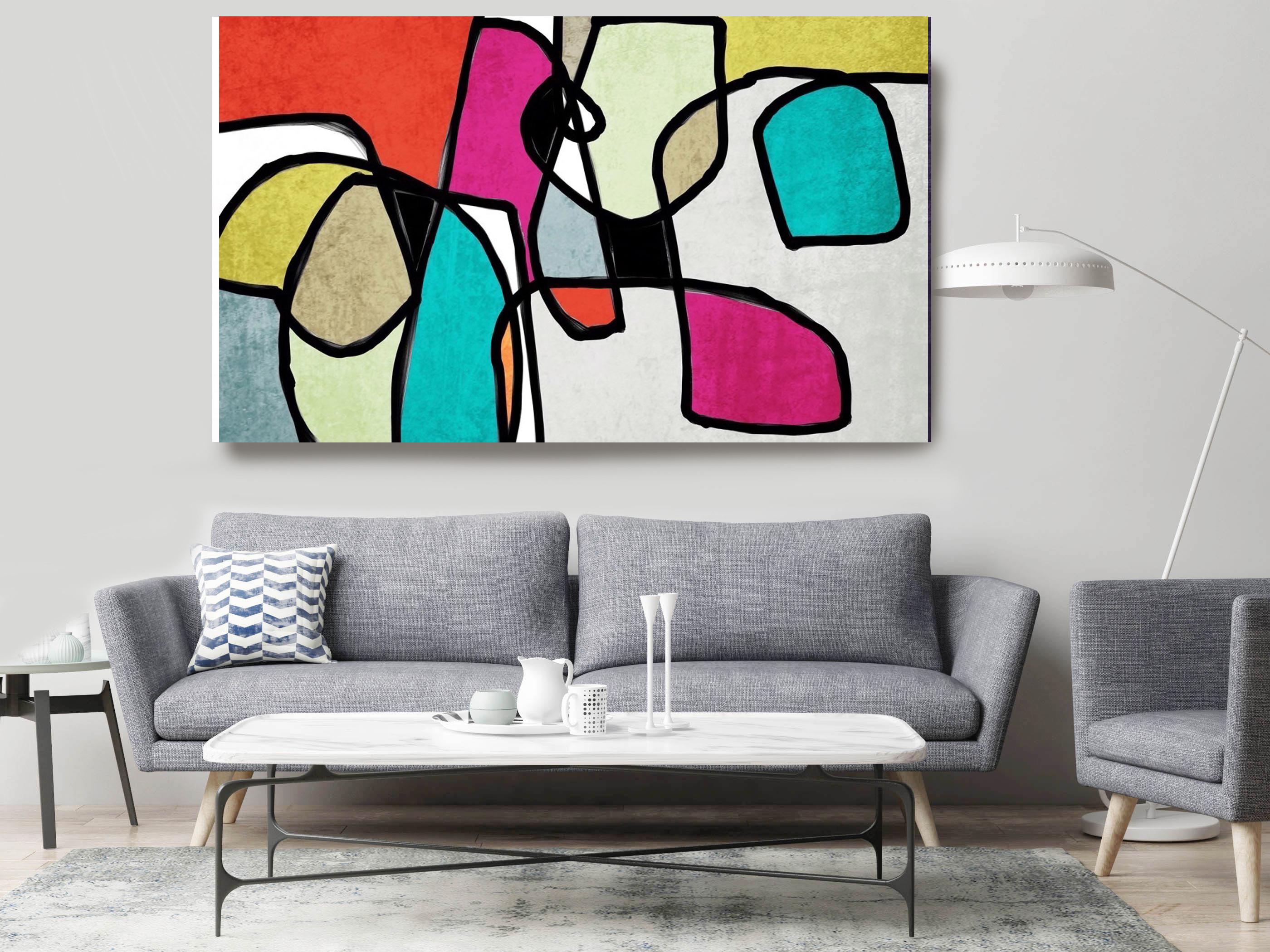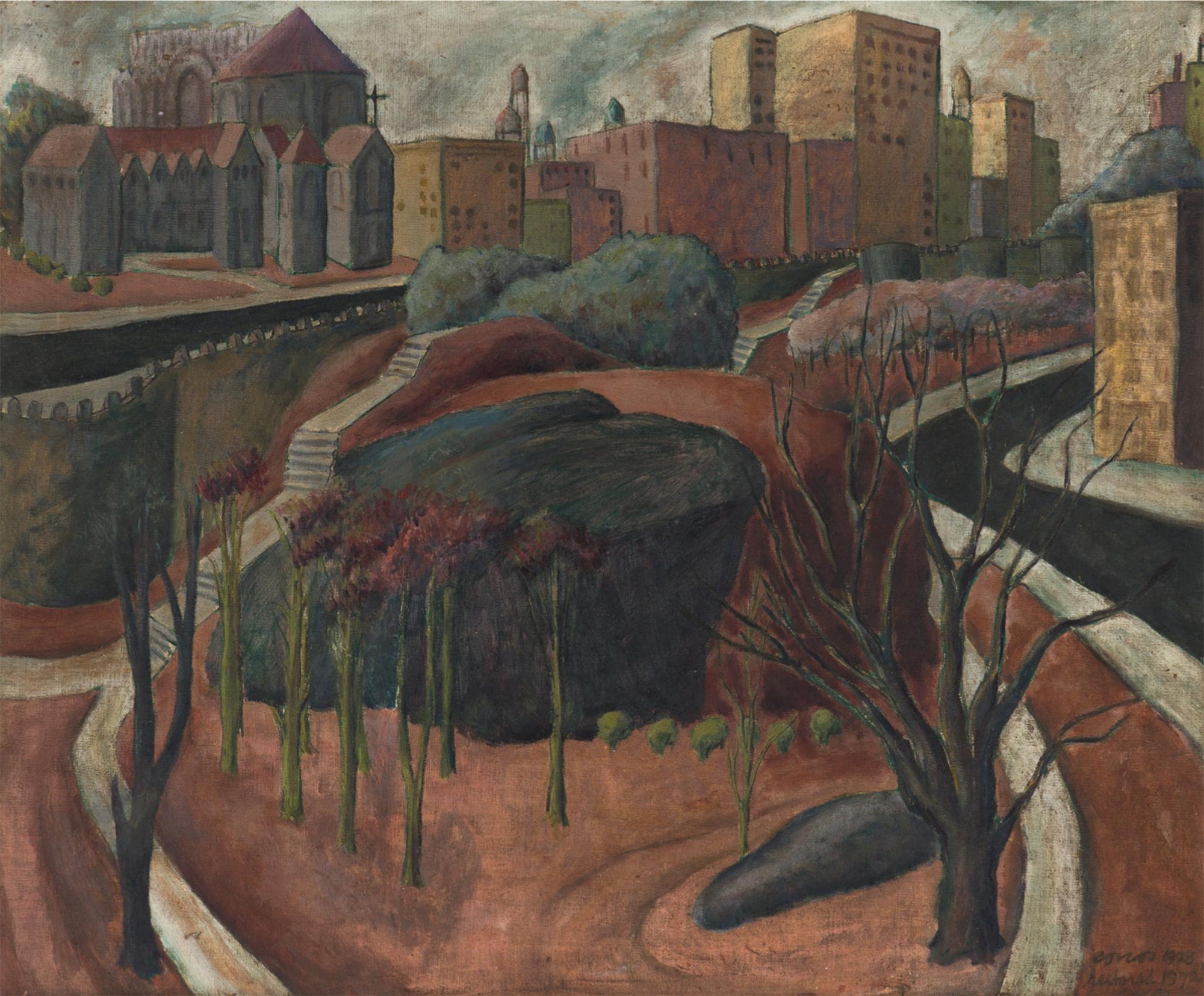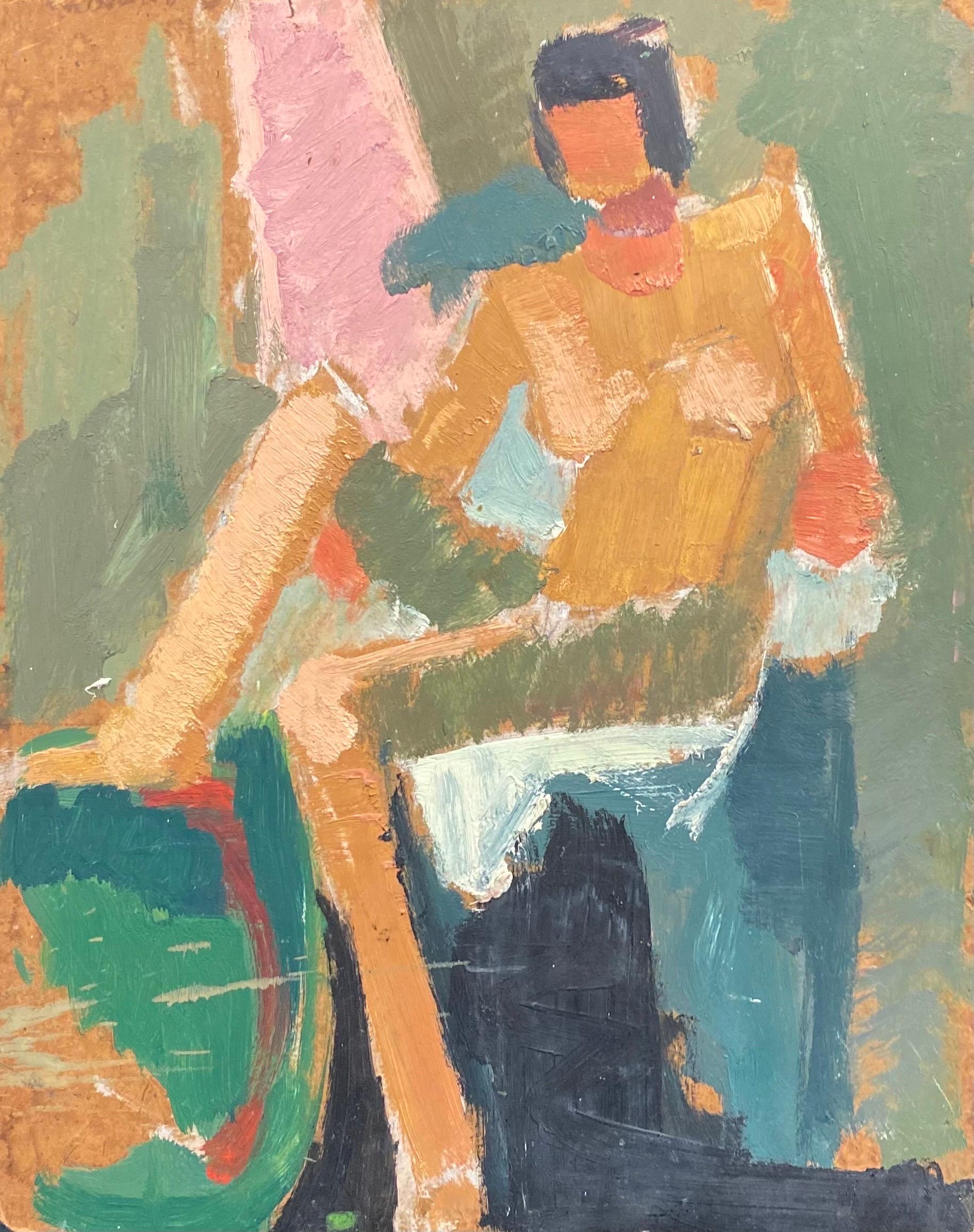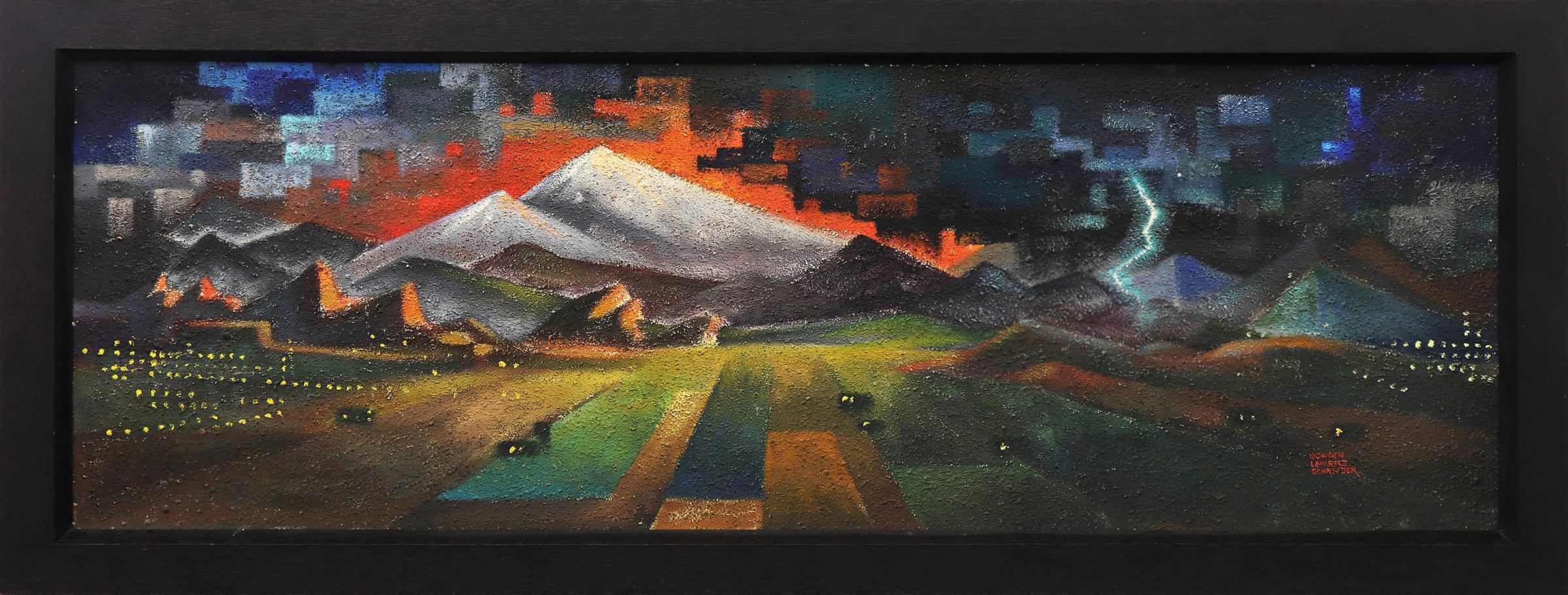Items Similar to Cubisme Composition, 1965 - oil paint, 79x62 cm., framed
Want more images or videos?
Request additional images or videos from the seller
1 of 8
Georges ArnulfCubisme Composition, 1965 - oil paint, 79x62 cm., framed1965
1965
About the Item
Oil on canvas, signed lower left
Georges Gaston Arnulf est un peintre et graveur français, né à Monte-Carlo (Monaco) le 23 mars 1921 et mort le 19 novembre 1996 au Thillay.
Georges Arnulf est originaire d'une ancienne famille niçoise. Il est le neveu de Gaston Arnulf, ancien conseiller général, et le fils d'un ancien hôtelier niçois. Il fait toutes ses études au lycée de Monaco et au lycée de Nice.
Après avoir suivi les cours de dessin et de décoration à l'École nationale des arts décoratifs de Nice, où il est l'élève de Jules Henri Lengrand, il est reçu en 1946 à l'École nationale supérieure des beaux-arts de Paris, présenté par Pierre-Henri Ducos de La Haille le 30 octobre 1947, il y fréquente les ateliers de fresque et de gravure. Il entre chez le taille-doucier Robert Cami où il continue son apprentissage du burin1, de l'eau-forte, de la manière noire.
Il obtient en 1950 le premier grand prix de Rome de gravure en taille douce2 et il est missionné pour réaliser l'étiquette de la bouteille du Château Mouton Rothschild 19503.
Pensionnaire à la villa Médicis à Rome pendant trois ans et demi4, il voyage et grave au burin l'illustration d'une édition de luxe des sonnets de Shakespeare traduits en français par François-Victor Hugo, préfacé par André Maurois (éditions Henri Javal, 1954).
Revenu à Paris en 1955, il réalise la mise en page et l'illustration au burin et à l'aquatinte d'un livre de poèmes de Philippe de Rothschild, Éclos à l'aube.
En 1956 il part pour le Liban comme conseiller artistique et technique de l'Imprimerie catholique de Beyrouth, au cours de cette période il effectue différents séjours en Égypte et en Asie mineure.
En 1957, il signe un contrat comme conseiller artistique attaché au service des publications du ministère de la Culture en Colombie.
Il est chargé par ailleurs de la conception et de la réalisation de 20 vitraux destinés à l'église coloniale San Francisco de Bogotà, qu'il mène à bien selon la technique traditionnelle avec l'aide d'un maitre-verrier.
Il exécute aussi les fresques de l'hôtel Tonchalà à Cucuta et dirige la restauration de 200 tableaux appartenant aux diverses églises de l'époque coloniale colombienne.
Il devient par la suite directeur artistique des éditions de la compagnie Seguros Colombia et de la banque Banco de construccion y desarrollo à Bogotà.
Attiré par l'immensité et la diversité des paysages colombiens, il visite les Llanos, l'Amazonie et les régions les plus reculées du Magdalena et du Huila : San Augustin et Tierradentro, vastes zones archéologiques, d'où il rapporte de nombreux croquis de sculptures monumentales et de fresques des nécropoles, qui viennent compléter ceux pris au musée national et au musée de l'or de Bogota.
Ce long travail est à l'origine de la collection des Estampes précolombiennes, à laquelle il se consacre dès son retour en France en 1966, et dont le premier volume paru en avril 1967 est présenté à la galerie-librairie de Gérard Mourgue à Paris5. La même année, pour se détendre du travail minutieux de la gravure, il réalise une fresque dans le patio de la villa Joya d'Alexandre Reza à Saint-Jean-Cap-Ferrat.
Il est alors nommé professeur de dessin à l'École nationale d'art décoratifs de Nice où il reste jusqu'en 1968, puis il obtient un poste — chargé de cours « Formes et graphismes » — à la faculté de Vincennes en 1969.
Il fait transporter sa presse, achetée avant son départ pour la villa Médicis et rangée chez ses parents, dans l'atelier de sa nouvelle maison au Thillay. Atteint de maladie de la moelle osseuse, il est hospitalisé durant des mois. En réaction à la souffrance et à l'immobilité, il dessine alors quantité de croquis à la pointe bic qui seront autant d'études pour ses futures gravures.
Les plus grands spécialistes le condamnent à très court terme, mais il guérit et reprend ses activités. Il se spécialise alors dans la réalisation de décorations murales en cuivres gravés de 10 à 20 m2 installées dans plusieurs facultés et lycées au Havre, Poitiers, Niort, Granville, ainsi qu'un monumental mobile en cuivre découpé et gravé, installé au-dessus de l'amphithéâtre du CES André Malraux à Louvres.
Dès lors, il est assisté dans ces réalisations et le tirage de ses gravures par son fils Georges Louis Arnulf6 qui est son apprenti et deviendra son taille-doucier exclusif. Dans le cadre de cet atelier familial, avec sa femme Mercedes conceptrice de bijoux en bronze, son œuvre gravé prend une nouvelle vigueur et les quinze années suivantes sont ses plus productives
- Creator:Georges Arnulf (1921 - 1996, Monacan)
- Creation Year:1965
- Dimensions:Height: 31.11 in (79 cm)Width: 24.41 in (62 cm)Depth: 1.97 in (5 cm)
- Medium:
- Movement & Style:
- Period:
- Condition:
- Gallery Location:Nice, FR
- Reference Number:1stDibs: LU52831498433
About the Seller
4.8
Vetted Seller
These experienced sellers undergo a comprehensive evaluation by our team of in-house experts.
Established in 1998
1stDibs seller since 2016
Typical response time: Several days
- ShippingRetrieving quote...Ships From: Nice, France
- Return PolicyA return for this item may be initiated within 1 day of delivery.
More From This SellerView All
- Table of Provence, 1960-65 - oil paint, 66x55 cm, framedBy LenziLocated in Nice, FROil on plywood, signed lower left.Category
Mid-20th Century Modern Abstract Paintings
MaterialsOil
- Le Bouquet, 1968 - Oil paint, 83x103 cm, framedBy Will H.TorehuysenLocated in Nice, FROil on canvas, signed lower right.Category
Mid-20th Century Modern Abstract Paintings
MaterialsOil
- Abstract Composition GS2, 1973 - Acrylic, 113x115 cm, framedBy Serée GérardLocated in Nice, FROil on canvas, signed on backCategory
1970s Modern Abstract Paintings
MaterialsAcrylic
- L'Estaque, 1985 - oil paint, 81x100 cm., framedBy Gérard AltmannLocated in Nice, FROil on canvas, signed lower Left Gérard Altmann, né à Paris le 23 septembre 1923 et mort à Paris le 19 avril 2012, est un peintre français. Il est le p...Category
Late 20th Century Abstract Impressionist Abstract Paintings
MaterialsOil
- Tribute to Albert Gleizes, 1935-40 - oil paint, 146x96 cm, framedBy R. BarlerinLocated in Nice, FROil on plywood, signed lower right Barlerin was disciple of Albert Gleizes.Category
20th Century Cubist Abstract Paintings
MaterialsOil
- Le Bouquet, 1955 - oil paint, 110x83 cm, framedBy Gérard AltmannLocated in Nice, FROil on canvas, signed lower left. Gérard Altmann, né à Paris le 23 septembre 1923 et mort à Paris le 19 avril 2012, est un peintre français. Il est le ...Category
Mid-20th Century Abstract Impressionist Abstract Paintings
MaterialsOil
You May Also Like
- “Abstract Sailing, 1945”By Nahum TschacbasovLocated in Southampton, NYOil on academy board by the Russian/American artist Nahum Tschacbasov. Signed and dated lower left, 1945. Condition: Excellent. Presently not framed. Biography : Russian-America...Category
1940s Modern Abstract Paintings
MaterialsOil, Fiberboard
- Mid Century Modern Oil Painting Canvas 48 x 71" Vibrant ColorfulBy Irena OrlovLocated in Sherman Oaks, CAMid Century Modern Oil Painting Canvas 48 x 71" Teal Pink SPECIFICATIONS: - Fine art canvas - Professionally hand stretched over 1 ½" deep wood stretched bars. The edges are painted...Category
2010s Modern Abstract Paintings
MaterialsCanvas, Oil
- Morningside Park, New York - Cathedral of St. John the DivineBy Lucille CorcosLocated in Miami, FLCorcos paints what appears to be the northern part Central Park from an elevated view looking northwest. The artist used a restricted palette of warm browns and grays with heavy outl...Category
1920s Modern Landscape Paintings
MaterialsCanvas, Masonite, Oil
- 20th Century German Modernist Oil Painting Nude Lady Model / Double Sided imageLocated in Cirencester, GloucestershireArtist: Elisabeth Hahn (German 1924-2021), Elisabeth Hahn was born in Dortmund, Germany, where she began her artistic studies. In 1953, she moved to Paris. She continued her studie...Category
20th Century Modern Figurative Paintings
MaterialsOil
- Southwestern Landscape Painting, Lightning Storm over Mountains, Semi AbstractLocated in Denver, COOriginal vintage painting of a Lightning Storm, Southwestern Mountain Landcape. Oil painting on textured board by Morton Lawrence Schneider (1919-2000). This large scale semi abstrac...Category
20th Century American Modern Landscape Paintings
MaterialsOil, Board
- Abstract Street (Untitled)By Hananiah HarariLocated in Los Angeles, CAThis painting is part of our exhibition America Coast to Coast: Artists of the 1930s Abstract Street (Untitled), 1939, oil on canvas, signed and dated lower right, 12 x 32 inches; provenance includes a private collection in Venice, California; presented in what is likely the artist's original handmade frame About the Painting The present work is the culmination of a series of mainly horizontal urban abstractions Harari completed between 1937 and 1939. Deeply influenced by Stuart Davis, Harari’s New York streetscapes began with clearly recognizable objects and landmarks as in Into New York (1937 - Collection of the Whitney Museum of American Art), New York Harbor (1937), Up and Downtown (1938), and his other mural proposals for the Nurses Home on Welfare Island (1937) and the Williamsburg Housing Project (1938). At the end of the series, Harari’s vistas became increasingly abstract with broad planes of color representing buildings and streets, the slightest cross-hatching forming a bridge or elevated train track and the vague suggestion of a streetlight looping in the right center of the composition. Figures, birds, and a street vendor’s cart are reduced to pictograms scratched into the surface of the canvas. Abstract Street (Untitled) is among Harari’s most spare works of the 1930s and 1940s and calls to mind the seemingly childlike, but deeply sophisticated works of Paul Klee from the 1920s. It serves as an excellent reminder of why Harari was heralded as one of the earliest members of the American Abstract Artists. About the Artist Hananiah Harari was an artistic polyglot who was equally at home working in styles as diverse as Cubism, Constructivism, Expressionism, Hard Edged Abstraction and trompe l’oeil Realism. A native of Rochester, New York, Harari initially studied as a child at the Memorial Art Gallery in his hometown and later as a scholarship student at the College of Fine Arts at Syracuse University. In 1932, Harari left for Paris where he befriended Nahum Tschacbasov, Benjamin Benno and John Graham and studied at the ateliers of Lhote, Leger and Gromaire. He also studied fresco painting at the Ecole de Fresque. By 1933, Harari had completed enough work and gained a sufficient reputation to have a solo exhibition at the American Club in Paris. The following year, Harari and his childhood friend and fellow artist Herzl Emanuel traveled to Palestine, where the artists worked hard in the orchards and fields of Kibbutz Deganiah, but produced little art. After returning to New York, Harari married Emanuel’s sister, Freda, and set out on the development of what noted scholar Gail Stavitsky has called an “original synthesis of the old and new." Harari became an early member of the American Abstract Artists (AAA), an organization formed to give modernists exhibition opportunities. Harari was also a member of the socially conscious Artist’s Union and the American Artist’s Congress. From 1936 through 1942, Harari worked on the Federal Art Project and assisted Marion Greenwood on a project as part of the Mural Division, but to his disappointment did not lead his own project. During the late 1930s and early 1940s, Harari completed a series of paired paintings with the same subject matter depicted in a Cubist manner and in trompe l’oeil Realism. Harari was acclaimed by Clement Greenberg and six of the artist’s works were selected for the Museum of Modern Art’s important 1943 exhibition American Realists and Magic Realists. During World War II, Harari served in the US Army Air Corps. Following the war, Harari continued to produce fine art while also producing commercial art. During the McCarthy Era, Harari’s progressive politics and leftist leaning art...Category
1930s American Modern Abstract Paintings
MaterialsOil
Recently Viewed
View AllMore Ways To Browse
1965 Abstract Art
Paint Pouring Art
1965 Oil On Canvas
Framed Poem
Colombian Paint
Oil Pourer
George Hotel
Monumental French Oil Painting
Oil Chateau
Monumental Abstract Oil Painting
Painted Louis Philippe
Saint George Painting
Colombian Oil Painting
Vintage Framed Poem
De Mouton
Mobile Oil
Monaco Oil Painting
Saint George Sculpture





